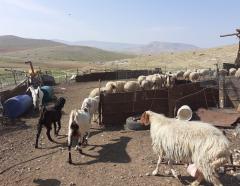
This preliminary document refers to a large-scale fencing work in the northern Jordan Beqaa Valley that began in early 2020 and continues today.
Placing a fence along many kilometers has wide environmental implications, in addition to the restriction on the grazing areas of Palestinian shepherds and their flocks, whose traditional grazing is their sole source of livelihood.
The information gathered so far with the assistance of Israeli volunteers who accompany the Palestinian shepherds in their daily routine throughout the year:
- The length of the fence that has been completed so far is about 15 km.
A fence begins at the settlement of Maskiyot in the direction of Umm Zuka and from Umm Zuka stretches south in the direction of settlement of Hemdat.
The fence passes through 'fire areas' and nearby nature reserves[1] and actually cuts the area into two, a western and eastern part. In fact, according to volunteers testimonies, fences cut the pastures of nearby Palestinian communities to the point where they may no longer exist.
- Apart from the restriction of grazing to Palestinian shepherds, the fence poses enormous environmental damage to the fauna of the area and reduces the living space of the animals in the area.
Financing and resources - It is not yet clear who is financing the construction of fences, but the fencing work carried out in the field is in a large area that requires significant financial resources and probably institutional assistance
[1] This issue is being examined whether the new fence crosses the area of the nature reserve, or passes very close to the border of the reserve. It is difficult to find up-to-date maps that follow the frequent changes in this area.

